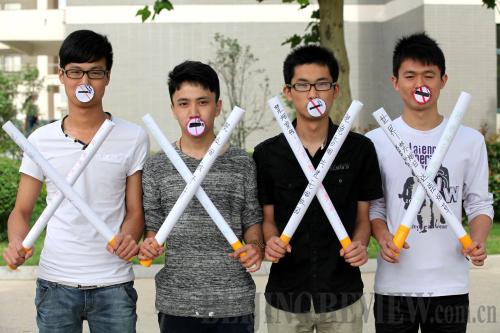|
 |
|
NO SMOKING: Students from Bozhou Technical College in Anhui Province call for greater anti-smoking efforts in a performance art show on May 30 (LIU QINLI) |
Smoking is one of the most fatal threats to the health of Chinese people. The country now has more than 350 million smokers, accounting for 35 percent of the world's total. Each year, about 1.2 million Chinese die from smoking-related diseases, according to the National Health and Family Planning Commission.
As a signatory country of the World Health Organization Framework Convention on Tobacco Control (WHO FCTC), China has pledged to comprehensively ban all tobacco advertising, promotion and sponsorship. Its Advertisement Law, enacted in 1994, stipulates that tobacco ads are not allowed in broadcasts, movies, television shows, newspapers or periodicals, and should not be placed in waiting rooms, cinemas, meeting halls or stadiums.
However, with the media landscape shifting, tobacco companies in China have found new ways to market their products.
On Yanyue.cn, an online Chinese community for smokers, visitors are being invited to take part in a jigsaw puzzle contest. Players will find the picture they complete is the logo of a cigarette brand. All prizes are packs of cigarettes.
More creatively, the Longyan Tobacco Industrial Co. Ltd. in southeast China's Fujian Province has implanted one of its brands into an online soccer game.
"All these online acts are essentially tobacco advertisements," said Li Qiang, a researcher with the Tobacco Control Office of the Chinese Center for Disease Control and Prevention (CDC).
An investigation by the Beijing Center for Disease Control and Prevention in May also drew the same conclusion. The investigation found advertisements related to tobacco in traditional media such as TV channels, newspapers and magazines have dropped sharply in recent years, but those in new media have seen a steep rise.
"Compared with traditional print media, the Internet provides many more opportunities for 'soft' tobacco advertisements, such as brand-planting," said Chen Feihong, a researcher with the Beijing CDC's Health Education Institute.
Worse still, there are no specific regulations on advertisements in Chinese new media, according to the institute's director Liu Xiurong. "This is a supervisory loophole," she said.
A new battle field
The 26th World No Tobacco Day came on May 31, with the theme of "banning tobacco advertising, promotion and sponsorship" this year.
The theme highlighted the WHO's efforts to ban all forms of tobacco advertising, promotion and sponsorship around the world to reduce the number of tobacco users and especially to keep young people from being addicted.
A WHO research report showed that about one third of youth experimentation with tobacco occurs as a result of exposure to tobacco advertising, promotion and sponsorship. Worldwide, 78 percent of young people aged 13-15 reported regular exposure to some form of tobacco advertising.
In China, a total of 220 million people were exposed to cigarette advertising via media platforms or sponsored events within a time span of 30 days, according to a survey conducted by the Chinese CDC in 2010.
"Today, tobacco companies are using new media, particularly social networking platforms, to circumvent regulations and target the younger generation," said Wu Yiqun, Deputy Director of the ThinkTank Research Center for Health Development, a Beijing-based non-governmental organization committed to tobacco control.
Official data show that China has more than 564 million Internet users, 420 million of whom access the Internet via cellphones.
Tobacco advertisers have turned to microblogs, the WeChat mobile phone instant messaging service, tobacco-themed online forums and tobacco company websites to promote their products, she said.
"Obviously, China's current regulations have not adapted to the shifting media landscape, which in general moves online and toward smartphones," said Huang Jinrong, a law researcher with the Chinese Academy of Social Sciences.
Li Tong from the ThinkTank Research Center said, when it came to new media, tobacco firms whitewashed their images by highlighting donations to public service programs and tried to raise consumer awareness of their brands by having celebrities endorse products in online videos.
| 